
conglomerate is knowi as Wuhan.
CM 0181 S
A MODULAR APPROACH
STUDENT WORKBOOK
MODULE 1: ORIENTATION
MODULE 2: BIOGRAPHIC INFORMATION
SPONSORED BY AGENCIES OF THE UNITED STATES AND CANADIAN GOVERNMENTS
This publication is to be used primarily in support of instructing military personnel as part of the Defense Language Program (resident and nonresident). Inquiries concerning the use of materials, including requests for copies, should be addressed to:
Defense Language Institute
Foreign Language Center
NonresidentTraining Division
Presidio of Monterey, CA 93944-5006
Topics in the areas of politics, international relations, mores, etc., which may be considered as controversial from some points of view, are sometimes included in the language instruction for DLIFLC students since military personnel may find themselves in positions where a clear understanding of conversations or written materials of this nature will be essential to their mission. The presence of controversial statements-whether real òr apparent-in DLIFLC materials should not be construed as representing the opinions of the writers, the DLIFLC, or the Department of Defense.
Actual brand names and businesses are sometimes cited in DLIFLC instructional materials to provide instruction in pronunciations and meanings. The selection of such proprietary terms and names is based solely on their value for instruction in the language. It does not constitute endorsement of any product or commercial enterprise, nor is it intended to invite a comparison with other brand names and businesses not mentioned.
In DLIFLC publications, the words he, him, and/or his denote both masculine and feminine genders. This statement does not apply to translations of foreign language texts.
The DLIFLC may not have full rights to the materials it produces. Purchase by the customer does net constitute authorization for reproduction, resale, or showing for profit. Generally, products distributed by the DLIFLC may be used in any not-for-profit setting without prior approval from the DLIFLC.
ORN Workbook, Unit 2
Example: (This example is limited to surnames.) The surnames Hū, Hú, Hǔ and Hù are listed on the chalkboard. Speaker 1 has taken the card for Hǔ from the deck of surname cards.
S2: Nī xìng Hú ma?
SI: Wǒ bú xìng Hú.
S3: Nī xìng Hù ma?
SI: Wo bú xìng Hù.
SU: Nī xìng Hū ma?
SI: Wǒ bú xìng Hū.
S2: Nī xìng Hǔ.
SI: Wǒ xìng Hǔ.
Practice Points: Xìng, jiao, and ma. Also, the Pronunciation and Romanization Module through Tape I*-Tor through Tape 5 if you have studied P&R 5)•
Standard Chinese: A Modular Approach originated in an interagency conference held at the Foreign Service Institute in August 1973 to address the need generally felt in the U.S. Government language training community for improving and updating Chinese materials to reflect current usage in Beijing and Taipei.
The conference resolved to develop materials which were flexible enough in form and content to meet the requirements of a wide range of government agencies and academic institutions.
A Project Board was established consisting of representatives of the Central Intelligence Agency Language Learning Center, the Defense Language Institute, the State Department's Foreign Service Institute, the Cryptologic School of the National Security Agency, and the U.S. Office of Education, later joined by the Canadian Forces Foreign Language School. The representatives have included Arthur T. McNeill, John Hopkins, and John Boag (CIA); Colonel John F. Elder III, Joseph C. Hutchinson, Ivy Gibian, and Major Bernard Muller-Thym (DLl); James R. Frith and John B. Ratliff III (FSI); Kazuo Shitama (NSA); Richard T. Thompson and Julia Petrov (OE); and Lieutenant Colonel George Kozoriz (CFFLS).
The Project Board set up the Chinese Core Curriculum Project in 197^ in space provided at the Foreign Service Institute. Each of the six U.S. and Canadian government agencies provided funds and other assistance.
Gerard P. Kok was appointed project coordinator, and a planning council was formed consisting of Mr. Kok, Frances Li of the Defense Language Institute, Patricia O’Connor of the University of Texas, Earl M. Rickerson of the Language Learning Center, and James Wrenn of Brown University. In the fall of 1977, Lucille A. Barale was appointed deputy project coordinator. David W. Dellinger of the Language Learning Center and Charles R. Sheehan of the Foreign Service Institute also served on the planning council and contributed material to the project. The planning council drew up the original overall design for the materials and met regularly to review their development.
Writers for the first half of the materials were John H. T. Harvey, Lucille A. Barale, and Roberta S. Barry, who worked in close cooperation with the planning council and with the Chinese staff of the Foreign Service Institute. Mr. Harvey developed the instructional formats of the comprehension and production self-study materials, and also designed the communication-based classroom activities and wrote the teacher's guides. Lucille A. Barale and Roberta S. Barry wrote the tape scripts and the student text. By 1978 Thomas E. Madden and Susan C. Pola had joined the staff. Led by Ms. Barale, they have worked as a team to produce the materials subsequent to Module 6.
All Chinese language material was prepared or selected by Chuan 0. Chao Ying-chih Chen, Hsiao-jung Chi, Eva Diao, Jan Hu, Tsung-mi Li, and Yunhui C. Yang, assisted for part of the time by Chieh-fang Ou Lee, Ying-ming Chen, and Joseph Yu Hsu Wang. Anna Affholder, Mei-li Chen, and Henry Khuo helped in the preparation of a preliminary corpus of dialogues.
Administrative assistance was provided at various times by Vincent Basciano, Lisa A. Bowden, Jill W. Ellis, Donna Fong, Renee T. C. Liang, Thomas E. Madden, Susan C. Pola, and Kathleen Strype.
The production of tape recordings was directed by Jose M. Ramirez of the Foreign Service Institute Recording Studio. The Chinese script was voiced by Ms. Chao, Ms. Chen, Mr. Chen, Ms. Diao, Ms. Hu, Mr. Khuo, Mr. Li, and Ms. Yang. The English script was read by Ms. Barale, Ms. Barry, Mr. Basciano-, Ms. Ellis, Ms. Pola, and Ms. Strype.
The graphics were produced by John McClelland of the Foreign Service Institute Audio-Visual staff, under the general supervision of Joseph A. Sadote, Chief of Audio-Visual.
Standard Chinese; A Modular Approach was field-tested with the cooperation of Brown University; the Defense Language Institute, Foreign Language Center; the Foreign Service Institute; the Language Learning Center; the United States Air Force Academy; the University of Illinois; and the University of Virginia.
Colonel Samuel L. Stapleton and Colonel Thomas G. Foster, Commandants of the Defense Language Institute, Foreign Language Center, authorized the DLIFLC support necessary for preparation of this edition of the course materials. This support included coordination, graphic arts, editing, typing, proofreading, printing, and materials necessary to carry out these tasks.

James R. Frith, Chairman
Chinese Core Curriculum Project Board
MODULE 1: ORIENTATION . About Communication Games ........... . .
About the C-2 and P-2 Tapes ....
UNIT 3
UNIT U
MODULE 2: BIOGRAPHIC INFORMATION
UNIT 1
UNIT 2
P-2 Workbook.......................59
P-2 Workbook......................
Communication Game A .............. ..... 86
Communication Game B................. . . . 9^
UNIT 5
UNIT 6
UNIT 7
UNIT 8
For the classroom activities called Communication-Games, the word "communication" is clearly appropriate. You are communicating. That is, you are purposefully exchanging information.
The word "games," however, has the drawback of suggesting a lack of seriousness, except perhaps for seriousness in competition. Communication Games are not meant to be entertaining breaks in the work of language learning, or rewards for that work. They are, instead, meant to be the most serious language-learning work of all. In fact, the only element of the games that is not serious is the occasional competition which may occur.
Once the intent of the activity is understood, the word "games" turns out to be handy and apt. As in other games, you will find that situations, rules, and goals have been made up for the Communication Games. Also, as in other games, the Communication Games succeed in imitating reality in various ways.
While expecting Communication Games to be serious work, you may find them entertaining and rewarding after all. If you do, it will probably be because you are communicating.
You are learning Chinese to be able to communicate in Chinese. Language has other functions. People often talk with each other merely to avoid an awkward silence. They often talk right past each other, to let something out, or talk to themselves, to work something out. But the essential function of language is communication. You want to understand and be understood.
In this course the assumption is made that you learn by doing. You learn to communicate by communicating. A lot of study time and even some class time must be spent on preparing to use the language, but no amount of preparation can take the place of trying to use the language.
It is not enough, however, for the teacher to say "Let’s talk." For one thing, you need something to talk about. The subject must be fairly definite if you are to be able to determine whether you have said what you wanted to say. Communication Games set up defined, limited situations to talk about.
For another thing, as a speaker you need to know something the listener does not know. Similarly, as a listener you should not have the information the speaker has. Otherwise, nothing that is said will really tell anybody anything, or have any real effect. You would lose the best evidence that you have said what you meant to say or have understood what you were meant to understand. In Communication Games, therefore, the players are provided with different information so that they can exchange this information.
To communicate, you need purpose. You need reasons for choosing to say or ask specific things. Your intention gives significance to what happens as a result of what you say. In Communication Games you will be given goals, such as the solution of a puzzle. Different ways to achieve the goals will occur to you as your knowledge of the situation changes and indeed as the situation changes.
The Communication Games in this course make rather different demands on you than most classroom language-learning activities. You may find yourself groping for the right words and for the right way to put them together, or groping for the right meaning. But when you work these problems out for yourself, you are really learning the language. You are doing exactly what you will have to do when you speak Chinese on your own later on—but somewhat more slowly and consciously, as is generally the case when beginning something new.
In other words, in Communication Games you are given opportunities to make mistakes. Without such opportunities, you have no chance to try out your understanding of how the language works.
The time for help from the teacher is after you have said something. After you put a sentence together, partly consciously and partly unconsciously, you are particularly sensitive to what it contains. You know what words you selected, what grammar you applied, what pronunciation you attempted, and what meaning you intended. A correction is likely to meet a recognized need, or at least to click neatly into place. Saying the sentence once or twice after the instructor says it will pull things together for you. Often you will find that you do not need specific help but can pick up hints from the conversation—again, partly consciously and partly unconsciously.
Obviously, you will "play" these Communication Games in Chinese. You should be able to say everything in Chinese, even to ask what an expression means or how to say something. Whatever you say in English is likely to tip your hand, to give away just enough of what you are trying to say to invalidate your attempt to say it in Chinese. (Nonverbal shortcuts can also ruin a game.)
At times, a word or two in English between you and the teacher may straighten out a problem, but these instances will be few. Fight that occasional temptation to lapse into English, particularly when commenting on a game or on your performance. By far the best policy is to swear off English for the duration.
INSTRUCTIONS:
Type: Fact-Gathering
Situation: You meet three people and exchange names.
Goal: To ask and find out the names of other people and to tell them your name.
Number of Players: Groups of four students or fewer.
Materials: A work sheet for each player. (See Sample Work Sheets, which follow.)
For the first round of the game, each male player assumes the man's name which is written on his work sheet. Female players assume women's names. For a second round, each male player assumes the woman's name written on his work sheet, and female players assume men's names. This arrangement will allow maximum practice in pronouncing different names.
Procedure: For these conversations, you should use the ’’mingling” approach (as you would mingle at a party); that is, mix freely with the other players in your group to exchange information (no fixed order).
Write down the names you learn in the empty boxes on your work sheet, using the correct Hànyǔ Pinyin romanization, including tone marks.
Example: You are Speaker 1 (Si). You are talking with your first partner (S2):
SI: Ni shi shéi?
S2: Wo shi MS Mínglì. NÌ xìng shénme?
SI: W8 xìng Fang. WS shi Fang BSolán.
Additional. Note: If you don't catch a name, ask again, as many times as necessary. You may also use the polite request Qīng ni zài shuō yícì, "Please say it again" (from the first tape of the resource module on Classroom Expressions). Qing ni is actually pronounced qíng ni.
Practice Points: Everything in Unit 1. Also, the Pronunciation and Romanization Module through Tape 2.
SAMPLE WORK SHEETS:
Full Name
|
(Mr.) | |
|
(Ms.) | |
|
(Mr.) |
Mǎ Mínglī |
|
(Ms.) |
Fang Baolán |
|
(Mr.) | |
|
(Ms.) | |
|
(Mr.) | |
|
(Ms.) |
Full Name
|
(Mr.) |
Huá Fānghǔ |
|
(Ms.) |
Lin Wénfēng |
|
(Mr.) | |
|
(Ms.) | |
|
(Mr.) | |
|
(Ms.) | |
|
(Mr.) | |
|
(Ms.) |
Full Name
|
(Mr.) | |
|
(Ms.) | |
|
(Mr.) |
Li Huánliàng |
|
(Ms.) |
Lù Wǎnfēng |
|
(Mr.) | |
|
(Ms.) | |
|
(Mr.) | |
|
(Ms.) |
Full Name
|
(Mr.) |
• |
|
(Ms.) | |
|
(Mr.) | |
|
(Ms.) | |
|
(Mr.) |
Hong YSuwéi |
|
(Ms.) |
Luò Hǎiyáo |
|
(Mr.) | |
|
(Ms.) |
Full Name
|
(Mr.) | |
|
(Ms.) | |
|
(Mr.) | |
|
(Ms.) | |
|
(Mr.) | |
|
(Ms.) | |
|
(Mr.) |
Fan Hèlóng |
|
(Ms.) |
Mao Wànfàng |
BLANK WORK SHEET:
Full Name
|
(Mr.) |
• |
|
(Ms.) | |
|
(Mr.) | |
|
(Ms.) | |
|
(Mr.) | |
|
(Ms.) | |
|
(Mr.) | |
|
(Ms.) |
INSTRUCTIONS:
Type: Guessing
Situation: You are one cf four people with similar-sounding surnames and similar-sounding given names. You know all the names involved but have to guess which name belongs to which person.
Goal: To guess people's surnames and given names.
Number of Players: Groups of four students or fewer.
Materials: One deck of cards with surnames written on them and another deck with given names. (There are enough names and cards for one group of players to play several rounds.)
Setting up: First, your teacher will write on the chalkboard a list of the surnames and given names to be used in the game.
Then, one player is selected to be the first person questioned, and he picks a surname card and a given-name card.
Procedure: For these conversations, you should use the "questioning by turns" approach; that is, each player takes a turn at being questioned by all the other players.
After the player to be questioned has selected his surname card and given-name card, the other players should then take turns trying to guess his surname and given name from the names on the chalkboard.' Use ma questions to guess his surname, unless there is only one possibility left, in which case the more appropriate choice is a simple statement of what his surname is.
When the players have guessed the first person's name, a surname card and a given-name card are given to another player, who is then questioned. Continue until each player has been questioned.
When you are questioning a player, do not follow the order in which the names are listed on the chalkboard. Instead, skip around. If you follow a recognizable order, everybody will know which name you are trying to pronounce. The purpose of the game, which is to be understood when pronouncing Chinese names, would thus be defeated.
Example: (This example is limited to surnames.) The surname.
and Hù are listed on the chalkboard. Speaker 1 has taken the care from the deck of surname cards.
S2: Nǐ xìng Hú ma?
SI: WǑ bú xìng Hú.
S3: Nī xìng Hù ma?
SI: Wǒ bú xìng Hù.
Sh: Nī xìng Hū ma?
SI: Wǒ bú xìng Hū.
S2: Nī xìng Hǔ.
SI: Wǒ xìng Hǔ.
Practice Points: Xìng, jiào, and ma. Also, the Pronunciation and Romanization Module through Tape b-(or through Tape 5 if you have studied P&R 5)»
CARDS—GIVEN NAMES
|
Zhiyīng |
Zhiyīng |
Zhiyīng |
Zhiyīng |
|
Bàoyī |
Eàoyì |
Bàcyí |
Eàoyī |
|
Qílóng |
Chílcr.g ____J |
Xílór.g |
Shílóng |
CARDS—SURNAMES
|
Zāng |
Cāng t |
Shāng |
Sang |
|
Zhang |
Chār.g |
v’iār.r |
Qiár.g |
|
Si |
Sū |
Shi |
XI |
The C-2 and P-2 tapes are designed to give you as cany benefits of communication practice as possible in self-study materials. The idea of communication with a tape instead of a partner contradicts itself, of course. The tape has no need to know or to tell. It has none of the flexibility of a human speaker. But practice with these tapes is the closest you can come to communication practice outside the'classroom and outside real life.
Some of the situations for the exercises are not like situations you will deal with in real life. The exercise situations are not intended to be realistic in this sense tut are intended to make the exercises more concrete.1 .In the exercises, the amount of concentrated practice with constructions and vocabulary items nurinp a few minutes of conversation might equal your exposure to these expressions over a period of days or weeks during a trip to China, i'er this reason you might find yourself, ’for-example,-playing. the role .of a hotel manager, or clerk, dealing with dozens _o.f guests1 rather than more, realistically acting as a guest..
. ‘Approach the communication tapes as you a:.; reached the Communication Games: expect to be challenged; expect tc work cut hew to say specific things to fit the.facts and requirements of a situation; and expect to learn from correction and repetition after having made your test stat at an answer. Don’t be concerned about making mistakes. You-are very likely to make mistakes at the beginning of an exercise, when you are getting the feel of it. Sometimes, you may still te making mistakes at the end of an exercise, in which,case you might profit from another run-through.
The communication tapes contain enough material in enough, variety to merit repeated use,'.either for initial learning or for review. Remember that these tapes are intended not as tests you should pass.handily or as assignments you must complete but rather as opportunities for you tc learn from the rough-and-tumble of the language in u1se.
Despite .the authors’.best efforts, instructions may not.afford immediate understanding of an activity, particularly if you have not already completed a similar activity in the classroom. After studying the instructions carefully, ycu may still find that you need to go through the first few items in an exercise before you understand fully what you are supposed to do.^ Examples in the instructions-are usually the first items in the taped exercises.
There are many appropriate answers to most questions in these exercises, and the tape can provide only one correct response. Often the answer provided will be a fuller response than would be given in everyday conversation on the principle that a fuller answer will imply the correct shorter answer and will be more worthwhile to repeat. At the same time, the answer will always be as airect as possible, never including more than is .actually, asked for.
You must use your own judgment in deciding whether y&ur answer was acceptable. If you recognize that the suggested answer given cn tape is what you intended to say and if you are reasonably'sure that your way of saying it is just as good, note that the answer could he said two ways. If you can see where you went wrong, note that. If you are not sure about your answer, the best thing you can de. is copy down the question anu'your answer and consult either the text ox- your instructor. Don’t let it bother you if a few problems remain unresolved.
Some additional vocabulary items are. introduced on the communication tapes for most units and are used for the drill tape,s and in class. There are just enough of these items to allow you to exploit the sentence types you are learning and to explore the situation'topics you are covering. The items are included in the instructions for the C-f and 1'-' exercises and may also be found in the.text Target Lists, Reference Lists, and Vocabularies for the units. 'Some items are'also in Resource Modules. .
A few comprehension.exercises contain sentences that are over your head. These over-the-heaǔ items are included, to givix you. practice in picking out the sentences you understand from a stream, of Chinese speech. You are not meant to try to learn these sentences.
Display I is a map of part of China showing the birthplaces of the four people named in the margins. Exercise 1 is a series of yes/no questions about these four people. After listening to each question, consult the map and answer the question "yes" or "no" by putting a check mark in front of the appropriate response. If the pause on tape before the speaker answers a question is not long enough, stop the tape.
DISPLAY I
Zhóu Qing
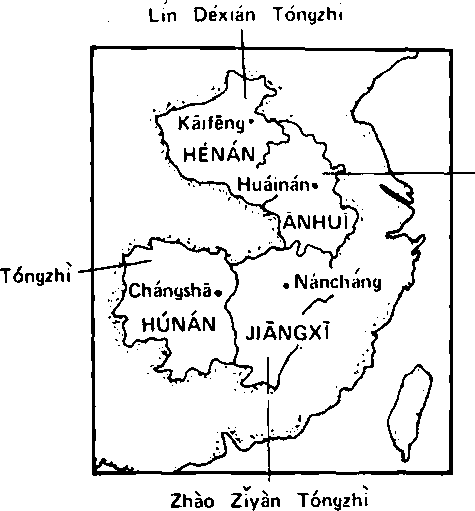
Jiang Shiyīng Tóngzhi
|
1. |
( |
) |
Yes |
( ) No |
7- |
( ) |
Yes |
( ) |
No |
|
2. |
( |
) |
Yes |
( ) No |
8. |
( ) |
Yes |
( ) |
No |
|
3. |
( |
) |
Yes |
( ) No |
o • |
( ) |
Yes |
( ) |
No |
|
U. |
( |
) |
Yes |
( ) No |
10. |
( ) |
Yes |
( ) |
No |
|
5. |
( |
) |
Yes |
( ) No |
11. |
( ) |
Yes |
( ) |
No |
|
6. |
( |
) |
Yes |
( ) No |
12. |
( ) |
Yes |
( ) |
No |
Display II is a map indicating the names and birthplaces of four people now living in Taipei. Exercise 2- is a series of questions about the people. After listening to each question-word question, put a check mark in front of the response that gives the information requested. After each yes/no question, check "yes" or "no." There is a pause on tape before the speaker answers each question.
(Notice that all the "yes" and "no" answers start out' with shì and bú shi.)
DISPLAY II
Tang Zhènhàn Xiānsheng
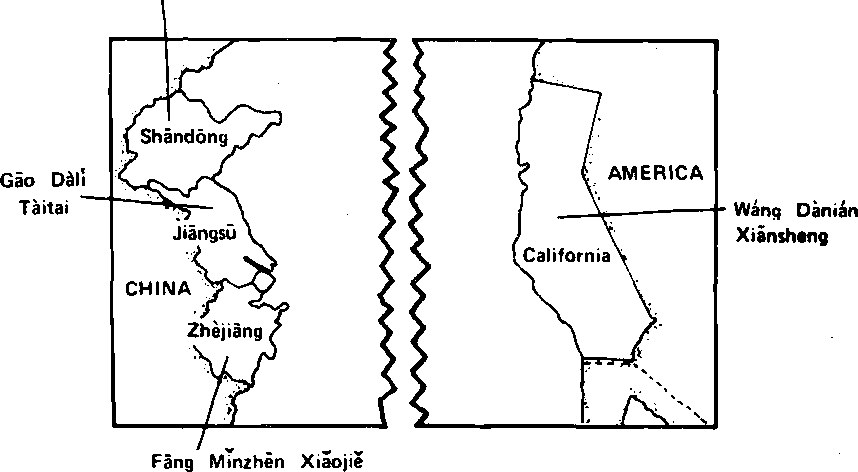
|
1. |
( |
) |
Californian |
( ) American |
( ) |
Yes |
( |
) |
No |
|
2. |
( |
) |
Californian |
( ) American |
( ) |
Yes |
( |
) |
No |
|
3. |
( |
) |
from Jiāngsū |
( ) Chinese |
( ) |
Yes |
( |
) |
No |
|
U. |
( |
) |
from Zhejiang |
( ) Chinese |
( ) |
Yes |
( |
) |
No . |
|
5. |
( |
) |
from Shandong |
( ) Chinese |
( ) |
Yes |
( |
) |
No |
|
6. |
( |
j |
from Zhejiang |
( ) Chinese |
( ) |
Yes |
( |
) |
No |
|
7. |
( |
) |
Californian |
( ) American |
( ) |
Yes |
( |
) |
No |
|
8. |
( |
) |
from Jiāngsū |
( ) Chinese |
( ) |
Yes |
( |
) |
No |
|
9- |
( |
) |
from Zhejiang |
( ) Chinese |
( ) |
Yes |
( |
) |
No |
|
10. |
( |
) |
from Shandong |
( ) Chinese |
( ) |
Yes |
( |
) |
No |
|
11. |
( |
) |
from Shāndōng |
( ) Chinese |
( ) |
Yes |
( |
) |
No |
|
12. |
( |
) |
from Jiāngsū |
( ) Chinese |
( ) |
Yes |
( |
) |
No |
In this exercise you will work on your comprehension of questions which ask who different people are and what their names are. For each item, a speaker will ask a question about the person whose name is written in this workbook after the item number. All the information you need to answer each question is in the underlined full name and title. Put a check mark in front of the answer that gives the information requested.
Example from the Tape:
SI: Tā shi shéi?
(pause on tape to allow you to mark your answer)
S2: Tā shi Lin Déxián Tóngzhì.
Example from the Workbook:
1. Lin Déxián Tóngzhì Lin Déxián Tóngzhì
Lin
( ) Déxián ( ) Yes ( ) No
1. Lin Déxián Tóngzhì
( ) Lin Déxián Tóngzhì ( ) Lin ( ) Déxián ( ) Yes ( ) No
2. Jiang Shìying Tóngzhì
( ) Jiang Shìying Tóngzhì ( ) Jiang ( ) Shìying ( ) Yes ( ) No
3. Zhao Ziyàn Tóngzhì
( ) Zhao Ziyàn Tóngzhì ( ) Zhao ( ) Ziyàn ( ) Yes ( ) No
U. Zhōu QIng Tóngzhì
( ) Zhōu QIng Tóngzhì ( ) Zhōu ( ) QIng ( ) Yes ( ) No
5. Táng Zhènhàn Xiānsheng
( ) Táng Zhènhàn Xiānsheng ( ) Táng ( ) Zhènhàn ( ) Yes ( ) No
6. Gāo Dall Tàitai
( ) Gāo Dàll Tàitai ( ) Gāo ( ) Dall ( ) Yes ( ) No
7. Fāng Mlnzhēn Xiāojiě
( ) Fāng Mlnzhēn Xiaojiě ( ) Fāng ( ) Mlnzhēn ( ) Yes ( ) No
8. Wang Dànián Xiānsheng
( ) Wang Dànián Xiānsheng ( ) Wáng ( ) Dànián ( ) Yes ( ) No
9. Lin Déxián Tongzhì
( ) Lin Déxián Tongzhì ( ) Lin ( ) Déxián ( ) Yes ( ) No
10. Jiang Shìylng Tongzhì
( ) Jiang Shìylng Tongzhì ( ) Jiang ( ) Shìylng ( ) Yes ( ) No
11. Zhào Zìyàn Tongzhì
( ) Zhào Ziyàn Tongzhì ( ) Zhào ( ) Ziyàn ( ) Yes ( ) No
12. Zhōu Qing Tongzhì
( ) Zhōu Qing Tongzhì ( ) Zhōu ( ) Qing ( ) Yes ( ) No
13. Tang Zhènhàn Xiānsheng
( ) Táng Zhènhàn Xiānsheng ( ) Táng ( ) Zhènhàn ( ) Yes ( ) No
14. Gáo Dàlī Tàitai
( ) Gáo Dàll Tàitai ( ) Gāo ( ) Dàll ( ) Yes ( ) No
15. Fang Minzhén Xiāojiě
( ) Fang Mlnzhēn Xiāojiě ( ) Fang ( ) Mlnzhēn ( ) Yes ( ) No-
16. Wáng Dànián Xiānsheng
( ) Wáng Dànián Xiānsheng ( ) Wáng ( ) Dànián ( ) Yes ( ) No
For each item in this exercise, a speaker will introduce himself. Indicate by a check mark which of the two romanized names is the one he gave. Then the speaker will tell you which one is and which one is not the one he gave. For example, if the speaker says
Wo shi Wáng Dànián
you should answer in your workbook OZ) Wang Dànián ( ) Huang Dànián
Then the speaker will say
Wǒ shi Wang Dànián, bú shi Huang Dànián.
(Notice that he mentions the names in left-to-right order.)
For another example, the speaker says
Wǒ shi Huang Dànián.
You should answer in your workbook ( ) Wang Dànián (l/) Huáng Dànián
Then the speaker will confirm:
Wǒ bú xìng Wáng, xìng Huáng.
(Again, you can rely on his mentioning the choice on the left first and the choice on the right second.)
U. ( ) Zhōu QIng
1U. ( ) Chāng Lìróng
|
( ) Lin Déqián ( ) Jiāng Zhiyīng ( ) Zhào Ziyàn ( ) Zhū QIng ( ) Tán Zhènhàn ( ) Gāo Dàlī Tàitai ( ) Feng Mlnzhēn ( ) Huáng Dànián ( ) Mā Zhìqiáng ( ) Sun Měilán ( ) Jiāng Huìwén ( ) Zhāng Yǒngpíng ( ) Li Huìrán ( ) Zhāng Lìróng ( ) Máo Sìmíng ( ) Guō Shàowén ( ) Luo Chéng ( ) Zhuāng Měizhēn ( ) Zhào Jièshí ( ) Shi Dàiwéi |
For each item, the speaker will tell you where he is from, twice. Write the place name in romanization, including the tone marks. If you need more time to complete an answer, stop the tape.
1.
2. ______________________________________________________________
3. _________________________________________________________________________
U. ________________________________________________________________________. ____________________________________
5. __________________________________________
6. ___________________________________________________________________________
7. ___________________________________________________________________________
8. __________________________________________________________
9- _________________________________________________________________________
10. ________________________________________________________________________
In this exercise you will fill in the boxes below with information from a recorded dialogue. You will hear the dialogue three times. As you listen to it for the third time, stop the tape whenever you hear information which you need to fill in a box. (The third time, there will be enough time between sentences for you to stop the tape and start it up again without missing anything.)2
|
MALE SPEAKER |
FEMALE SPEAKER |
OTHER PERSON TALKED ABOUT | |
|
SURNAME |
- | ||
|
GIVEN NAME | |||
|
NATIONALITY | |||
|
PLACE OF ORIGIN |
Display I, on the next page, is a map of part of China showing the birthplaces of the four people named in the margins. Use the information in the display to answer the questions in this exercise. The speaker will ask each question twice. Then he will pause to allow you to answer. (You may stop the tape to give yourself more time if you cannot come up with an answer right away.) After this pause, the speaker will give you a correct answer and then pause again to allow you to repeat it. An example precedes the first item on the tape.
Your answer may be different from the speaker's answer but still perfectly correct. If you are not sure whether yours is right or not, make a note and consult your instructor later.
Display II, on the next page, shows the names and birthplaces of four people now living in Taipei. Use the display to answer the questions in this exercise. The speaker will follow the procedure used for asking questions in Exercise 1.
The names of the eight people in Display I and Display II are numbered. When the speaker says "Number One," that means that the following questions will be about the person with the number 1 next to his name. After the speaker says "Number Two," your answers should be about Máo Zhìmín Tongzhì. And so forth.
Questions will not be repeated. After each question there will be a pause for your answer, then a confirmation from the speaker, and then a pause for repetition.
DISPLAY I * U

conglomerate is knowi as Wuhan.
DISPLAY II * 8
Chén Yongpmg Taitai

5
Wang Dànián Xiānsheng
*The numbers included in this display are for use in completing Exercise 3.
In the conversation on tape, Edward Smith, from Pennsylvania, is meeting someone for the first time in Taipei. After each question addressed to Smith, try to give the answer before he does. (You may stop the tape before answering.) Further instructions are on the tape.
Here is the information you will need for this exercise:
SI Déhuá
(Edward Smith)
Bīnzhōu
(Pennsylvania)
INSTRUCTIONS:
Type: Matching
Situation: The setting is Taipei. You are one of four married people who meet and talk about what provinces they and their husbands or wives are from.
Goal: To find people who come from the same province.
Number of Players: Groups no larger than four players.
Materials: A work sheet for each player. (See Sample Work Sheets, which follow.) Your work sheet shows your name, your home province, and the home province of your spouse.
Procedure: For these conversations, use the "mingling" approach; that is, mix freely with the other players in your group to exchange information (no fixed order).
When you find someone from your province, say in Chinese "I'm also from . . . ." Complete your work sheet by filling in the home provinces of the other players and their spouses as you learn them.
Example: You are Speaker 1 (Si).
SI: Nín guìxìng?
S2: W3 xìng Mǎ. Nì shi shéi?
SI: WǑ shi Lí Shoutiān. Mǎ Xiānsheng, nǐ shi nǎrde rén?
S2: Wo shi Shāndōng rén.
SI: Mǎ Tàitai shi nǎrde rén?
S2 Tā shi Héběi rén.
SI: Wǒ ye ("also") shi Héběi rén.
Additional Note: Notice in the last line of the example that the new word yě, "also," is used before the verb shi. Yě is not introduced until Unit U, but try to use it now when you point out a match.
Practice Points: Nǎrde rén, (province) rén.
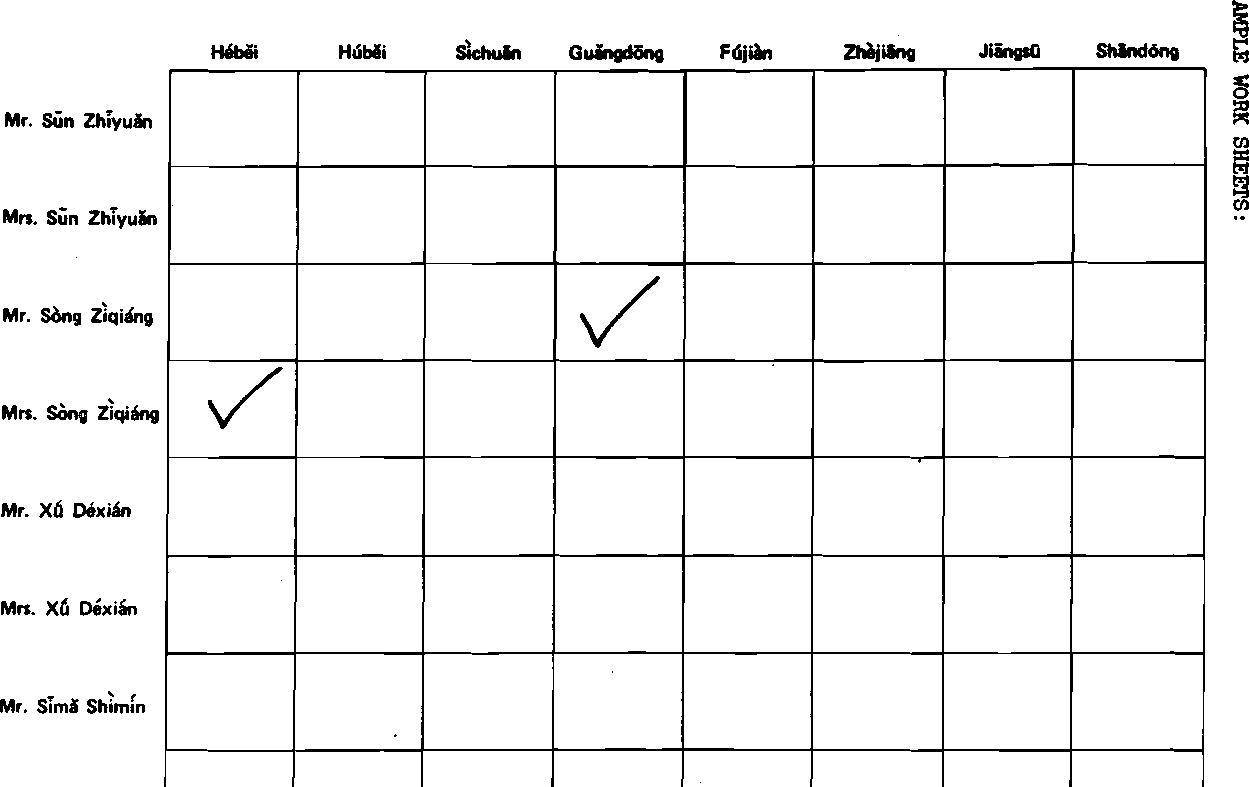
Mrs. Sima Shimín
ORN Workbook, Unit 3

ORN Workbook, Unit 3
r\> oo

ORN Workbook, Unit 3
ro
M3
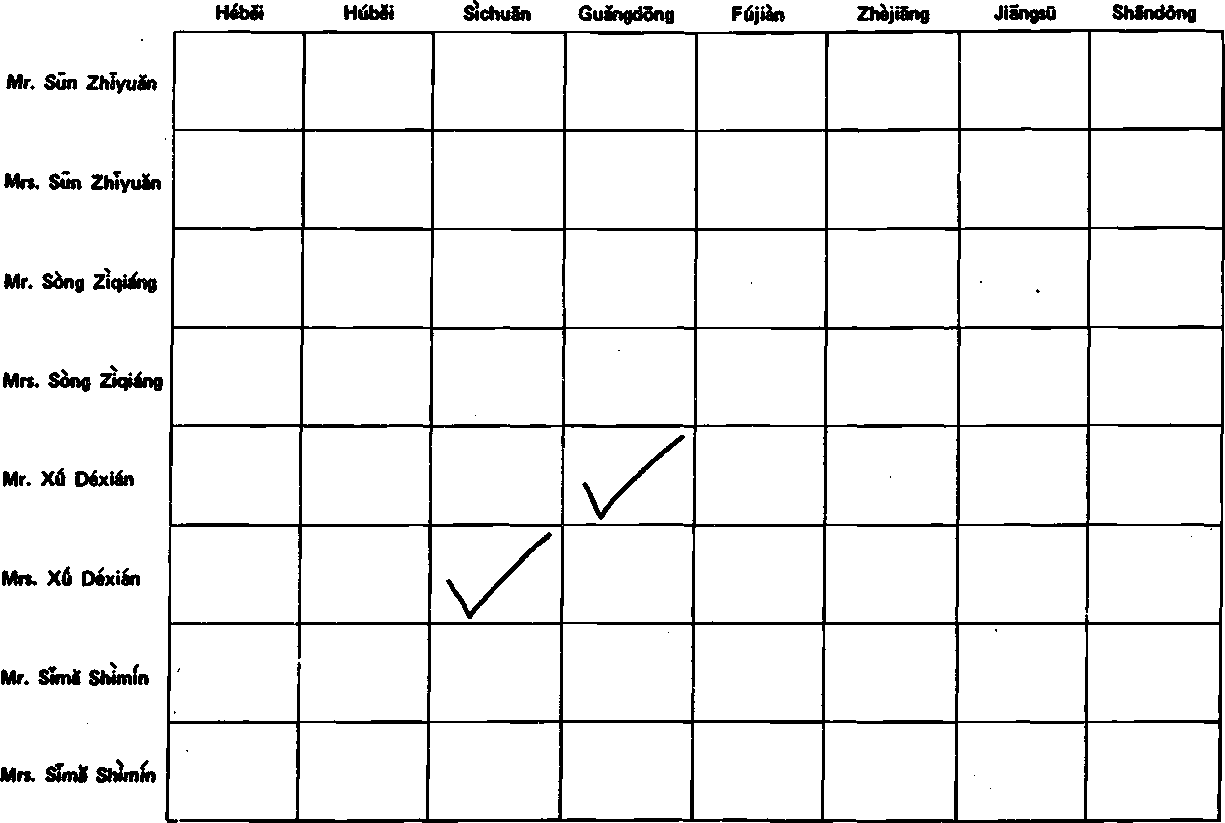
ORN Workbook, Unit 3
This exercise is based on a conversation between Mr. Davis and Comrade Qián, who have just met. You will hear the conversation three times. As you listen to it for the third time, stop the tape as needed to write down information required to complete the chart below.
Here are vocabulary items you will need for this exercise:
Niǔyiiēzhōu (New York State)
Bīnzhōu (Pennsylvania)
|
HOME STATE OR PROVINCE |
PRESENT LOCATION | |
|
Mr. Davis (Dàiwéisī) | ||
|
Comrade Qián | ||
|
Mrs. Davis | ||
|
Comrade Qián’s husband |
In this exercise you will listen to fifteen recorded passages in which the names of people’s home provinces are mentioned. After hearing each passage, write in Pinyin romanization the name of the person’s home province in the blank beside his name.
You will hear each passage twice. After listening for the second time, fill in the blank. You may stop the tape if you need extra time to write, and you may rewind if you need to listen again.
|
1. |
Wáng Guìfān |
HOME PROVINCE |
|
2. |
He Róngwiáng | |
|
3. |
Sun Guópíng | |
|
U. |
Feng Guóān | |
|
5. |
Li Bǎoyí | |
|
6. |
Zhōu Shàohuá | |
|
7- |
Wú Yùfān | |
|
8. |
Chen Shūyí | |
|
9. |
Zhōu Dàyōu | |
|
10. |
Shěn Xiùyīng | |
|
11. |
Táo Ailing | |
|
12. |
Yáng Wěiguó | |
|
13. |
Qián Wěidá | |
|
1U. |
Zheng Zhìpíng | |
|
15. |
Huang Huìzhū | |
|
16. |
Zhū Xiùméi | |
|
17. |
Bái Mínghuā __ |
This exercise is based on a conversation between Mr. Bailey and Comrade Fāng which takes place when they happen to meet on the street. They have been introduced previously but have never had a chance to talk.
The conversation has deliberately not been edited to the point where you can understand everything, but you should be able to understand enough to complete the chart below. Imagine yourself in China, listening to a conversation between two fluent speakers of Chinese. Try to understand as much as you can.
You will hear the conversation three times. As you listen to it for the third time, stop the tape as needed to write down information.
|
HOME STATE OR PROVINCE |
PRESENT LOCATION | |
|
Mr. Bailey (Bèilì) | ||
|
Comrade Fāng | ||
|
Mrs. Bailey | ||
|
Comrade Fang’s husband |
In this exercise you will practice talking about where people are in terms of ’’here" and "there."'
The Display I diagram sets the scene. The two speakers on tape are standing in front of the Beijing Hotel. (They are represented by the solid triangle Cthe man 3 and the solid circle Cthe woman!.) Comrade Gāo and Comrade Zhao are standing nearby, near enough to be considered "here," although neither is in the conversation. Comrade MS and Comrade Chén are in sight across the street, definitely "there." (These four people are represented by the outline triangles and circles.)
During the pause on tape after each question asked by the First Speaker try to give an answer. Then you will hear the Second Speaker’s answer. Repeat it during the pause which follows.
DISPLAY I
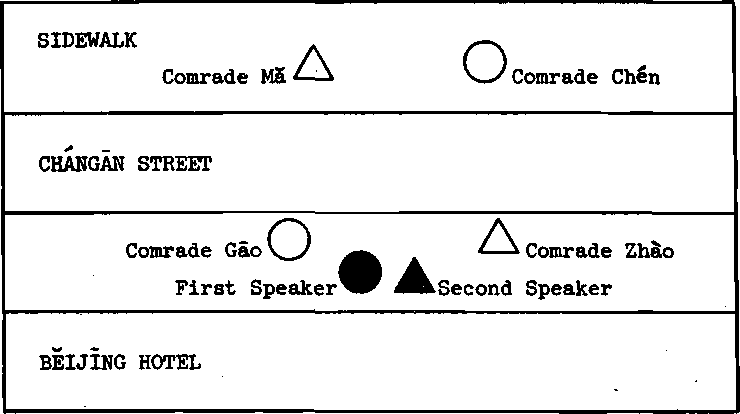
In this exercise you will talk about where people are from and where they are now.
Display II contains the information needed to answer the questions on tape. This display shows the birthplaces and present locations of three people. The solid arrows show that Comrade Li was bom in Sichuan and that Comrade Lu (his wife) and Comrade Lǔ were born in Yúnnán. The broken arrows show that Comrade Li and his wife are presently in Sichuan and that Comrade Lú is in Yúnnèn. (This exercise does not make reference to the cities of Chéngdū and Kunming.)
Answer each question, and repeat the acceptable answers which follow your responses. If you need time to work out an answer, stop the tape. Keep in mind that your answer may have been perfectly correct even if it was not worded exactly like the answer on tape. You should be able to decide whether your answer was correct or not. If you are not sure, write down the question and your answer, and consult your teacher later.
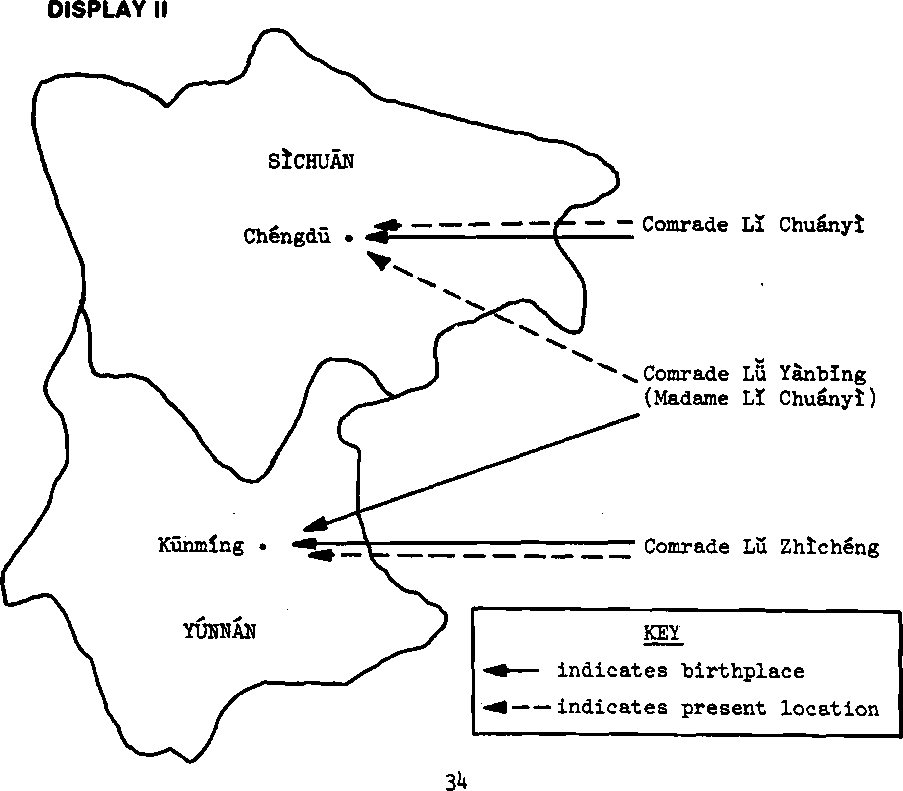
This exercise is a continuation of Exercise 2 and is based on Display II. In this exercise the cities of Chengdu and Kunming are ment ioned.
This exercise gives you a chance to answer questions you are likely to be asked when first meeting someone.
In the recorded dialogue, Comrade Qian is beginning a conversation with Mr. Davis. They are in Běijīng. Use the information in Display III to answer each question asked by Comrade Qián. Then listen to Mr. Davis’ answer. Finally, repeat his answer.
DISPLAY III
|
SURNAME |
Davis |
(Dàiwéisī) | |
|
COUNTRY |
U.S. |
(Měiguō) | |
|
HOME STATE |
New York State |
(Niǔyuēzhōu) | |
|
WIFE'S PRESENT LOCATION |
New York State |
(Niǔyuēzhōu) | |
|
WIFE’S HOME STATE |
Pennsylvania |
(Binzhōu) |
INSTRUCTIONS:
Type: Matching
Situation: The setting is Taipei. You are talking with someone about what provinces eight other people are from and what provinces they happen to be in now.
Goal: To find people from the same home province or people who are now in the same province.
Number of Players: Pairs of students.
Materials: A fact sheet for each player. (See Sample Fact Sheets, which follow.)
Each of the four arrows on a fact sheet is labeled with a person's name and leads from his home province to the province where he is now. The names of the four people your partner knows about are listed in the lower left-hand corner of the fact sheet.
Procedure: Each player should ask about the home provinces and current locations of the four people his partner knows about. (No fixed order for asking questions.) While questioning your partner, scan your fact sheet for matches. When you find a match, point it out immediately, using the word yě, "also."
Example: You are Speaker 1.
SI: Táng Yǒngpíng lāojiā zài nǎr?
S2: Tā lāojiā zài Hebei.
SI: Tā xiànzài zài nār?
S2: Tā xiànzài zài Shandong.
SI: Li Shìmín xiànzài yě zài Shāndōng.
Additional Note: If you don't recognize the name of a province or if you don't know where a province is, refer to the map in your textbook. You may also ask your teacher where a province is, but only in Chinese!
Practice Points: Lāojiā zài, xiànzài zài, yě.
SAMPLE FACT SHEETS:
Táng Yǒngpíng Zhōu Huìwén Jiāng ZhīyuSn Gāo Yùzhēn
Li Shìmín Zhāng Juān Li Déxián Zhào Wānrú
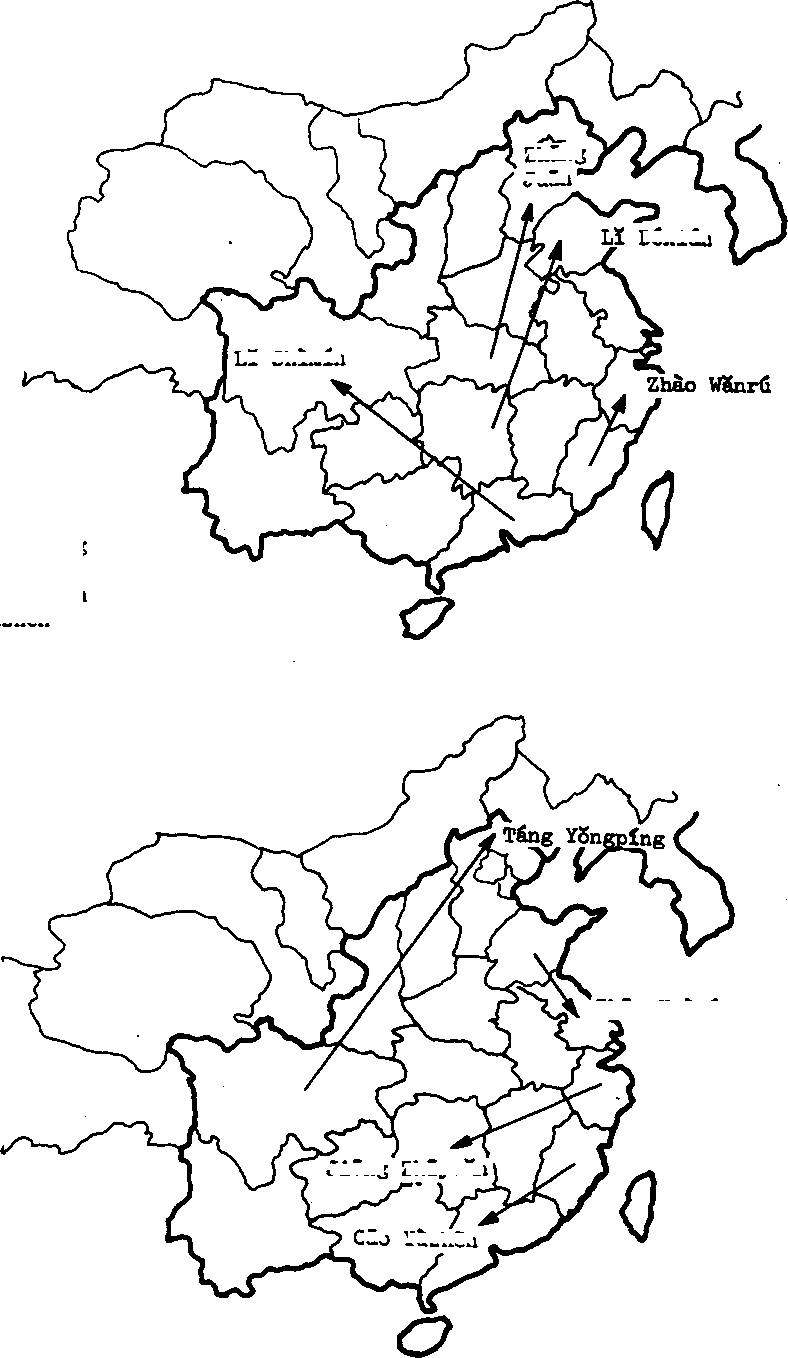
Déxián
Li Shìmín
Zhìyuan
Jiang
Yūzhēn
Gao
Zhang
Juan
Zhōu Huìwén
Táng Yǒngpíng Zhōu Huìwén Jiang Zhīyu&n Gāo Yùzhēn

Ll Dexián
Zhao Wanrū
Zhang Juān
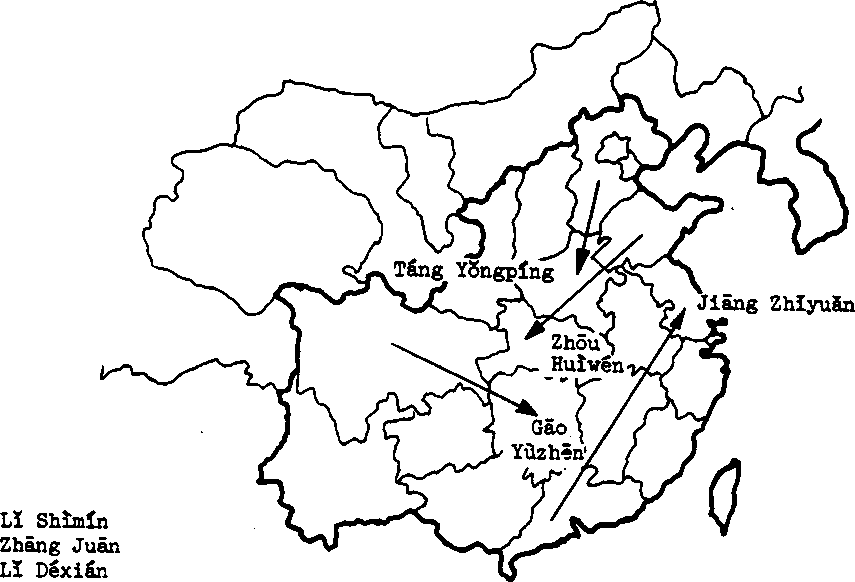
Zhào Wǎnru

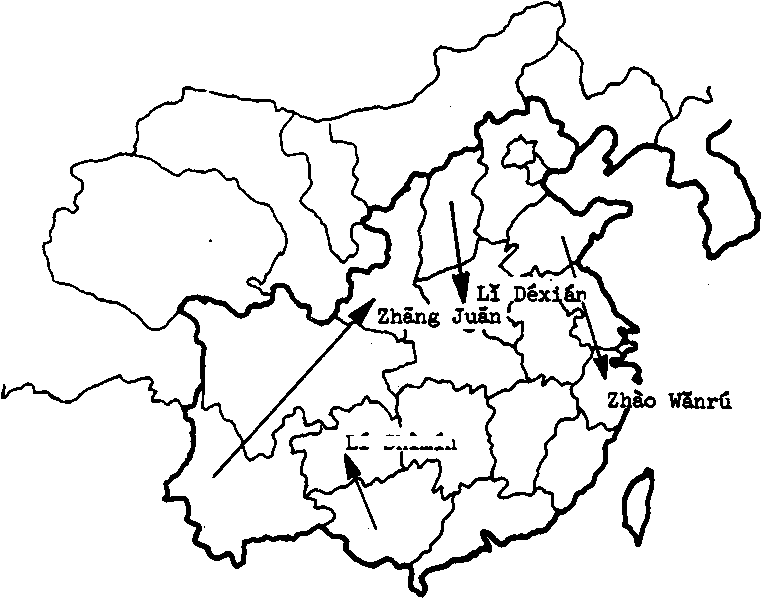
LÍ Shìmín
Táng Yǒngpíng Zhōu Huìwén Jiang Zhīyuán Gāo Yùzhēn


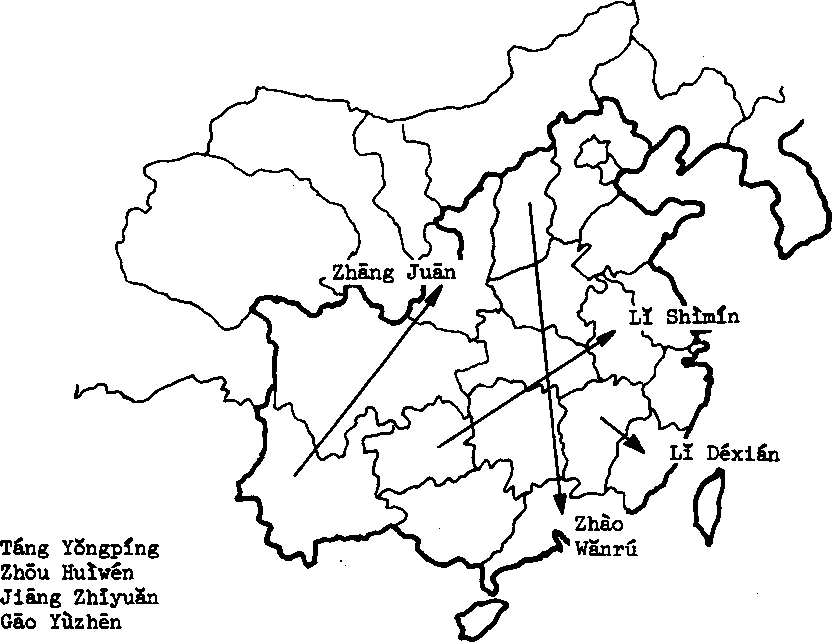
LI Shìmín Zhāng Juān Li Déxián Zhào Wānrú
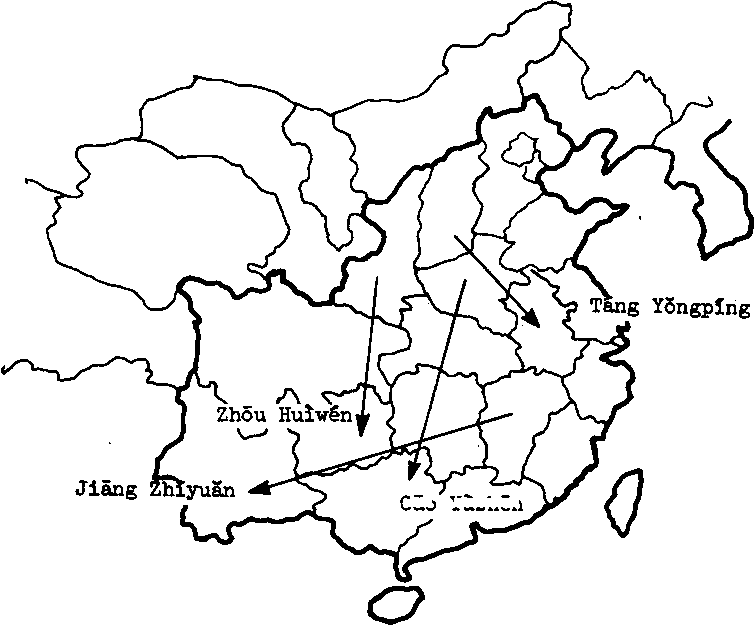
Yūzhēn
Gao
Module & Unit
|
a àiren |
(question marker) spouse |
1.2 l.U |
|
ba |
(marker for a question which |
2.2 |
|
expresses the speaker’s supposition as to what the answer will be) | ||
|
bàba |
papa, dad, father |
2.3 |
|
bìng |
to become ill |
2.8 |
|
Bīnzhou |
Pennsylvania |
1.3’, l.U’ |
|
bù/bú |
not |
1.2 |
|
bú shi |
not to be |
1.2 |
|
bú zài le |
to be deceased |
2.5* |
|
cóngqián |
before, previously |
2.6 |
|
dà |
to be large |
2.8’, CE 2 |
|
dàfàndiàn |
hotel |
2.2 |
|
dào |
to arrive |
2.U |
|
dàshī |
ambassador |
2.2’ |
|
dàxíié |
university |
2.7 |
|
-de |
(possessive marker) |
2.2 |
|
Déguó (Déguo) |
Germany |
1.3 |
|
Déwén |
German language |
2.7*, 2.8 |
|
Dezhōu |
Texas |
l.U |
|
dì- |
used in forming ordinal numbers |
l.U |
|
dìdi |
younger brother |
2.3 |
|
Dìyī Dàfàndiàn |
First Hotel (name of a hotel in |
2.2’ |
|
Taipei) | ||
|
dìzhī |
address |
2.2 |
|
dong |
to understand |
2.8’, CE 1 |
|
dōu |
all, both |
2.3 |
|
duì |
to be correct |
2.8*, CE 1 |
|
duìbuqǐ |
I’m sorry, excuse me |
l.U’ |
|
duì le |
yes, that’s right |
2.1, CE 1 |
|
duo dà |
how old |
2.5 |
|
duo jiù |
how long |
2.6 |
JOTE: The * symbol appears after the module and unit reference for vocabulary items which are not required either for comprehension or production.
Éguó (Èguó)(-guo) Russia èr two
1.3
NUM 1
2.5, T&D 1
2.H
Èryiiè (Èryiiè) February
érzi son
|
Fǎguó (Fàguó)(-guo) |
France |
1.3 |
|
fānchéng |
to translate into |
CE 2 |
|
fàndiàn |
hotel; restaurant |
2.1 |
|
Fawén (Fawén) |
French language |
2.?’, 2.8 |
|
fāyīn |
pronunciation |
CE 2 |
|
fùmu |
parents |
2.3 |
|
fùqin |
father |
2.3 |
|
fūren |
Mrs., Lady, Madame; a very polite word for the wife of a high-ranking person |
1.1+ |
|
-ge |
(general counter) |
2.1 |
|
gēge |
older brother |
2.3 |
|
gēn |
and; with |
2.3 |
|
gōngzuò |
to work |
2.2 |
|
guìxìng |
your honorable surname |
1.2 |
|
-guó |
country |
1.3 |
|
-guo |
(experience marker) |
2.6 |
|
Guóbīn Dàfàndiàn |
Ambassador Hotel (name of a hotel |
2.2 |
in Taipei)
|
hái |
still |
2.3 |
|
haijūn |
navy |
2.8 |
|
háizi |
child, children |
2.3 |
|
hao |
to be good, to be well |
2.'2 |
|
-hào |
no. (in addresses, etc.); day of |
2.2 |
|
the month | ||
|
hen |
very |
2.1 |
|
hòunián (hòunian) |
the year after next |
2.5, T&D 2 |
|
hòutiān (hòutian) |
the day after tomorrow |
2. It, T&D 2 |
|
huì |
to know how to, can; to have |
2.7, 2.8 |
|
the skill or knowledge of, | ||
|
to know | ||
|
huídá |
to answer, to reply |
CE 2 |
|
Jl- |
how many |
2.3 |
|
Jiā |
plus; to add |
NUM 1+ |
|
Jia |
home |
2.2 |
|
-Jiā |
(counter for institutions) |
2.3’ |
|
Jiāli |
family |
2.3 |
|
Ji an |
to meet |
CE 2 |
|
Jiànádà |
Canada |
l.U |
|
Jiao |
to be called, to be given-named |
1.2 |
|
Jiāzhōu |
California |
1.3 |
|
Jiē |
street |
2.2 |
|
jiéhūn (jiehūn) |
to get married, to be married |
’ 2.U* |
|
jiějie |
older sister |
2.3 |
|
jiěmèi |
sisters |
2.3 |
|
jǐge xǐngqī |
how many weeks |
2.6 |
|
Jǐge yuè |
how many months |
2.6 |
|
jìhào |
what day of the month |
2.5, T&D 1 |
|
JīngJixué |
economics |
2.7 |
|
Jínián |
how many years |
2.6 |
|
Jīnnián (jǐnnian) |
this year |
2.5, T&D 2 |
|
jíntiān (jintian) |
today |
2.U, T&D 1 |
|
jǐsuì |
how old |
2.5 |
|
jǐtiān |
how many days |
2.6 |
|
Jiǔ |
nine |
NUM 2 |
|
Jiù |
only |
2.3 |
|
Jiǔyūè (Jiǔyūe) |
September |
2.5, T&D 1 |
|
Jíyǐiè |
what month |
2.5 |
|
junguān |
military officer |
2.8 |
|
junrén |
military person |
2.8 |
|
kè |
class |
2.8 |
|
kěshi |
but |
2.U* |
|
kongjun |
air force |
2.8 |
|
lái |
to come |
2.U |
|
iSojiā |
’’original home” |
l.U |
|
lǎoshī |
teacher |
CE 2 |
|
le |
(combined le: new-situation |
2.U |
|
and completion marker) | ||
|
le |
(new-situation marker) |
2.5 |
|
le |
(completion marker) |
2.6 |
|
liǎng |
two |
2.3 |
|
llbàijí |
what day of the week |
T&D 2 |
|
Líbàitian |
Sunday |
T&D 1 |
|
Líbàiyī • |
Monday |
T&D 2 |
|
ling |
zero |
NUM 1 |
|
lìshǐ |
history |
2.7 |
|
liù |
six |
NUM 1 |
|
Liùyǔè (Liùyiie) |
June |
2.5, T&D 1 |
|
lù |
road |
2.2 |
|
luguǎn |
hotel |
2.1’ |
|
lùjun |
army |
2.8 |
|
ma |
(question marker) |
1.2 |
|
mama |
momma, mom, mother |
2.3 |
|
man |
to be slow |
CE 2 |
|
méi |
not, not to have |
2.3 |
|
Me i guó (Me i guo) |
America, United States |
1.3 |
|
Měiguo Guojì |
U.S. International Communica- |
2.2* |
|
Jiāoliú Zongshǔ |
tions Agency | |
|
Měiguo Guowùyiiàn |
U.S. State Department |
2.7 |
|
Měiguo Yínháng |
Bank of America |
2.2’ |
|
méi Jiéhūn |
not to be married |
2.1*’ |
|
mèimei |
younger sister |
2.3 |
|
méi(you) |
not to have; there isn’t/aren’t |
2.3 |
|
-men |
plural suffix |
2.3 |
|
Měngtèruì |
Monterey |
2.7° |
|
míngnián |
next year |
2.5, T&D 2 |
|
(míngnian) | ||
|
míngtiān |
tomorrow |
2.1*, T&D 2, CE 2 |
|
(míngtiān) | ||
|
míngzi |
given name |
1.2 |
|
mǔqin |
mother |
2.3 |
|
nà |
that |
2.2 |
|
nàge |
that (one) |
2.2 |
|
nali |
where |
2.2 |
|
náli |
Not at all! |
2.7 |
|
nàli |
there |
2.2 |
|
nan |
to be difficult |
2.7 |
|
nánháizi |
boy |
2.3 |
|
nanpéngyou |
boyfriend |
2.3' |
|
nar |
where |
1.1* |
|
nàr (nèr) |
there |
1.1* |
|
ne |
(question marker) |
1.2 |
|
něi- |
which |
2.1 |
|
něige |
which |
2.1 |
|
nèige |
that |
2.1 |
|
něigué |
which country |
1.3 |
|
něinián |
which year |
2.5 |
|
něitiān |
which day |
2.1* |
|
nèr (nàr) |
there |
1.1* |
|
nǐ |
you |
1.1 |
|
-nián |
year |
2.5, T&D 2 |
|
nianji |
age, years old |
2.5’ |
|
niánnián |
every year |
2.5 |
|
niàn shū |
to study |
2.7 |
|
niàn |
to study |
2.7 |
|
nǐmen |
you (plural) |
2.3 |
|
nín |
you (polite) |
1.2 |
|
Niǔ Yǔē |
New York |
2.6 |
|
Niu Yuē Zhōu |
New York State |
l.U |
|
nuer |
daughter |
2.U |
|
nuháizi |
girl |
2.3 |
|
nushì |
Ms., Miss; lady |
l.U |
|
nutóngzhì |
(female) Comrade |
2.3 |
|
péngyou |
friend |
2.2 |
|
pǔbù |
waterfall |
2.3' |
|
seven |
NUM 2 | |
|
qiánnián |
the year before last |
2.5 |
|
(qiánnián) qianti an |
the day before yesterday |
2.U |
|
(qiántian) qīngchu |
to be clear |
CE 2 |
|
Qingdao |
Qingdao (a city in Shandong |
l.U |
|
province) | ||
|
qlngwèn |
May I ask... |
l.U |
|
Qīyǔè (Qíyue) |
July |
2.5, T&D 1 |
|
qunián (qúnian) |
to go last year |
2.6 2.5, T&D 2 |
|
rén |
person |
1.3 |
|
Rìbēn |
Japan |
1.3 |
|
Rìwén |
Japanese language |
2.7 |
|
róngyi |
to be easy |
2.7 |
|
sān |
three |
NUM 1 |
|
Sānyǔè (Sānyǔe) |
March |
2.5, T&D 1 |
|
Shandong |
Shandong (a province of China) |
l.U |
|
shàngge |
last, previous (i.e., last month, |
2.5*, T&D 2 |
|
shàngge yǔè) | ||
|
shàngge xīngqī |
last week |
2.5*, T&D 2 |
|
shàngge yuè |
last month |
2.5°, T&D 2 |
|
Shanghai |
Shànghǎi |
1.3 |
|
shàng kè |
to begin class, to attend class |
CE 1 |
|
shàoxiào |
major (military title) |
2.2 |
|
shēi |
who |
1.1 |
|
shēng |
to be born |
2.5 |
|
shēngyln |
voice, sound, noise |
CE 2 |
|
(shēngyin) | ||
|
shénme |
what |
1.1 |
|
shénme dìfang |
where, what place |
2.7’ |
|
shénme shíhou |
when, what time |
2.1+ |
|
shi |
ten |
NUM 2 |
|
shi |
to be |
1.1 |
|
shi |
yes, that’s so |
2.1 |
|
shìbīng |
enlisted man |
2.8 |
|
shi de |
yes, that’s so |
2.2 |
|
shi...-de |
(focus construction) |
2.U |
|
Shíèryūè (Shíèryue) |
December |
2.5, T&D |
|
shìguān |
sergeant |
2.8’ |
|
shíhou |
time |
2.1+ |
|
Shíyiyūè (Shíyiyue) |
November |
2.5, T&D |
|
Shíyuè (Shíyue) |
October |
2.5, T&D |
|
shū |
book |
2.7’ |
|
shuō |
to say, to speak |
CE 1 |
|
shuō |
to speak a language |
2.7 |
|
shuō |
to say that... |
2.7 |
|
shuōcuò |
to speak/say incorrectly |
CE 2 |
|
SI |
four |
NUM 1 |
|
Sìyuè (Sìyíie) |
April |
2.5, T&D |
|
-suì |
year (of age) |
2.5 |
|
suìshu(r) |
age |
2.5’ |
|
tā |
he, she, it |
1.1 |
|
tài |
too, excessive |
CE 2 |
|
tàitai |
Mrs., wife |
1.1 |
|
Taiwan Yínháng |
Bank of Taiwan |
2.2' |
|
tāmen |
they |
2.3 |
|
-táng |
class period |
2.8’ |
|
-tian |
day |
2.1+ |
|
tiāntiān |
every day |
2.1+' |
|
ting |
to listen |
2.8’, CE 1 |
|
tóngzhì |
comrade |
1.1 |
|
Wàijiāo Xuéyìiàn |
Foreign Service Institute |
2.7’ |
|
wài zǔfù |
maternal grandfather |
2.3 |
|
wàizǔmǔ |
maternal grandmother |
2.3 |
|
-wèi |
(polite counter for people) |
2.1 |
|
wen |
to ask (for information) |
1.1+’, CE 2 |
|
wèntí |
question, problem |
CE 2 |
|
wénxíié |
literature |
2.7 |
|
wǒ |
I, me |
1.1 |
|
women |
we, us |
2.3 |
|
wǔ |
five |
NUM 1 |
|
Wǔguānchù |
Defense Attache’s Office |
2.2 |
|
Wǔyuè (Wǔyūe) |
May |
2.5, T&D 1 |
|
xiàge |
next (i.e., next month, xiàge yǔè) |
2.5*, T&D 2 |
|
xiàge xlngqí |
next week |
2.5*, T&D 2 |
|
xiàge yuè |
next month |
2.5* |
|
xià kè |
to end class |
CE 1 |
|
xiang |
to think that; to want to, would like to |
2.5*, 2.6 |
|
xiansheng |
Mr., sir |
1.1 |
|
xiànzài |
now |
l.U |
|
xiǎojiě (xiáojie) |
Miss |
1.1 |
|
xiě |
to write |
2.8 |
|
xièxie |
thank you |
2.2 |
|
xìng |
to be surnamed |
1.1 |
|
xìngqǐ |
week |
2.6, T&D 2 |
|
xīngqijǐ |
what day of the week |
2.5, T&D 2 |
|
Xíngqǐtiān |
Sunday |
2.5, T&D 2 |
|
Xíngqìyl |
Monday |
2.5, T&D 2 |
|
xiōngdì |
brothers |
2.3 |
|
xiōngdì Jiěmèi |
brothers and sisters |
2.3 |
|
xué |
to study |
2.7 |
|
xūéshēng (xuésheng) |
student |
2.7 |
|
xuéxí (xuéxi) |
to study, to learn (PRC) |
2.7 |
|
yě |
also |
l.U |
|
yí |
one |
NUM 1 |
|
yícì |
once, one time |
CE 1, CE 2 |
|
yìdiǎn(diǎn) (yìdiǎnr) |
a little |
2.7, CE 2 |
|
yíge rén |
singly, alone |
2.U |
|
yíhào (yíhào) |
the first day of the month |
2.5 |
|
yíjǐng (yíjing) |
already |
2.U |
|
Yíjiǔ nian |
the year 19 |
2.5 |
|
Yíngguó (Yíngguo) |
England |
1.3 |
|
yíng le |
won |
2.3 |
|
Yíngwén |
English language |
2.7 |
|
yínháng |
bank |
2.2 |
|
yìsi |
meaning |
CE 1 |
|
Yiyuè (Yíyuè) (-yue) |
January |
2.5 |
|
you f |
to have; there is/are |
2.3 |
|
yōuzhèngjú |
post office |
2.2’ |
|
yuè |
month |
2.5, T&D 1 |
|
zài |
again |
CE 1 |
|
zài |
to be in/at/on |
l.U |
|
zài |
in/at/on (prepositional verb) |
2.2 |
|
Zǎo. |
Good morning. |
2.1, CE 1 |
|
zěnme |
how |
CE 2 |
|
zhè |
this |
2.2 |
|
zhège |
this (one) |
2.2 |
|
zhèi |
this |
2.1 |
|
zhèige |
this |
2.1 |
|
zhèige yuè |
this month |
2.U°, 2.5° |
|
zhèli |
here |
2.2 |
|
zhèngzhixué |
political science |
2.7 |
|
zhèr |
here |
l.U |
|
zhǐ |
only |
2.3 |
|
zhidao |
to know |
2.8°, CE 1 |
|
Zhōngguó |
China |
1.3 |
|
(Zhōngguó) | ||
|
Zhōngguó huà |
Chinese (spoken) language |
2.7 |
|
Zhōngwén |
Chinese language |
2.7 |
|
zhù |
to stay, to live |
2.1, 2.6 |
|
zì |
character (of Chinese writing) |
2.8 |
|
zǒu |
to leave |
2.U |
|
zǔfù |
paternal grandfather |
2.3 |
|
zǔmǔ |
paternal grandmother |
2.3 |
|
zuò |
to do, to make |
2.7 |
|
zuò shì |
to work |
2.8 |
|
zuótiān (zuōtian) |
yesterday |
2.5 |
210
This comment applies as well tc many of the classroom communication activities.
A good bit of the dialogue is over your head, but all the information you need is in sentences you should be able to understand.